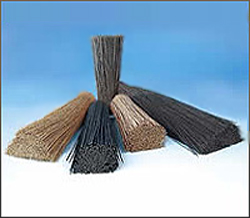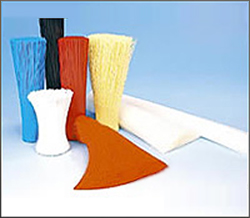Fill Configuration
There is a free choice of fill configurations
Please specify the fill density in every brush you need.
The respective performance of the brush depends to a great extent on the choice of fill density.
We can help you choose the right density in conjunction with the material used.
| Helical & Spiral Shape pattern
|
Straight Filled Pattern | Full-fill pattern |
|
 |
 |
 |
 |
| dense, e.g. single row - arrow form | dense, e.g. single row | Field fill density in axial direction - dense fill |
high fill density |
 |
 |
 |
 |
| light, e.g. two rows - arrow form | dense, e.g. two rows | Field fill density in axial direction - dense fill |
standard fill density |
 |
 |
 |
 |
| dense, e.g. two rows - arrow form | light, e.g. two rows |
Field fill density in axial
direction - minimal fi |
low fill density |
Fill-material

The fill-material is the most important part of a technical brush, as it carries out the brushing action. According to this, the selection for the type of wire has to be properly conceived and analyzed.
The fill-material can be provided as stiff or soft type of wire, either thick or thin filament, highly resistant to chemical agents or to high temperatures, quite flexible, particularly bending, deforming and abrading-proof too.
For special purposes, it is possible to combine and mix diverse wire assortments, in accordance to pre-definite mixing combinations.
The wires working strength is determined by both length of the surface of contact and its density: this concept finds its application especially in the wheel brushes assembly.

It is strictly advised to bear in mind that both the exploiting temperature and the chemical agents concentration may be very important during the brushings session, as the end user may exploit the brush through various rating performances.
Before any exploitation, it is also advised to test the brush in the same working conditions.
POLYESTERE-PET-PBT: High stiffness combination, hardness and durability.
PBT: Polybutile for food industry.
POLYPROPYLENE: High resistance to chemical factors, low density and low resistance to low temperatures.
NYLON 6 / 6.6: High resistance and stiffness, stable for dimensions and low thermal expansion. Exploitable for liquids spreading and cleaning abrasive surfaces and materials.
NYLON 6.12: Tough and resistant to abraadability, humidity absorption lower than NYL 6. The type of wire offers the highest abrading resistance and water absorption performances. It is suggested for brushing in water and any other tough brushing environment.
NYLON ABRASIVO: High resistance and stiffness, it keeps its shape and performs a very high abrading resistance, just like the NYL 6.12 but an abrasive composition. Exploitable for deburring metals, plastic materials, for smoothing and rusticating wooden surfaces.
TAMPICO VEGETAL FIBER: Not subjected to static electricity, used primarily for surface treatment of wood, for polishing metals and for sealing purposes in higher temperature range.
HORSE HAIR: Not subjected to static electricity, excellent wiping, sealing and dusting effect, used for sealing purposes, spree ding liquids (excellent brushing effect) dusting veneered or laminated wooden surfaces.
PIG BRISTLE: Not submitted to electricity, excellent wiping, sealing and dusting effect, similar exploitations to horsehair but stronger bristles.
STEELS: General sealing purposes at higher temperatures, deburring and cleaning of metal surfaces.
STAINLESS STEEL: It is corrosion resisted and ideal brushing stainless steels, derivative alloys, aluminium and other materials that have to avoid contamination. A contamination can result in exploiting carbon steel wire brushes, as the carbon’s metal residues can cause rust. It is recommended not to use the same type of brush to scrub different quality of the materials. Furthermore, it is important to avoid any brush’s contamination with reference to the surfaces where carbon steel surfaces are subjected to the brushing action. At last, it is recommended to passive all the stainless steel surface with appropriate solutions after the brushing treatment, in order to get the stainless steel natural resistance to the corrosion.
General Fiber Characteristics
| 6 NYLON | 6.6 NYLON | 6.12 NYLON | POLYPROPYLENE | HORSE HAIR | TAMPICO | |
| Heat Distortion (F) | 250 | 300 | 250 | 225 | 370 | 283 |
| Melting Point | 410 | 500 | 405 | 330 | ||
| Bend Recovery (%) | 90 | 90 | 90 | 70-80 | execl. | poor. |
| Shelf Life | execl. | execl. | execl. | good | poor | fair |
| Abrasion Resistance | good | execl. | execl. | good | good | poor |
| Specific Gravity (G/CC) | 1.13-4 | 1.13-4 | 1.04-5 | .90-1 | ||
| Tensile Strength (PSI) | 50-60M | 60-70M | 50-60M | 50-80M |
Chemical And Environmental Resistance
| 6 NYLON | 6.6 NYLON | 6.12 NYLON | POLYPROPYLENE | HORSE HAIR | TAMPICO | |
| Dilute Alkalis | execl. | execl. | execl. | execl. | poor | good |
| Dilute Acids | good | good | good | execl. | poor | good |
| Strong Acids | fair | fair | good | good | g-poor | g-poor |
| Alcohols | good | good | good | execl. | poor | good |
| Petroleum Distilates | execl. | execl. | execl. | good | poor | good |
| Hot Water | fair | good | good | fair | poor | good |
| Alcohols, Vegetable Oils | good | good | good | execl. | poor | good |
